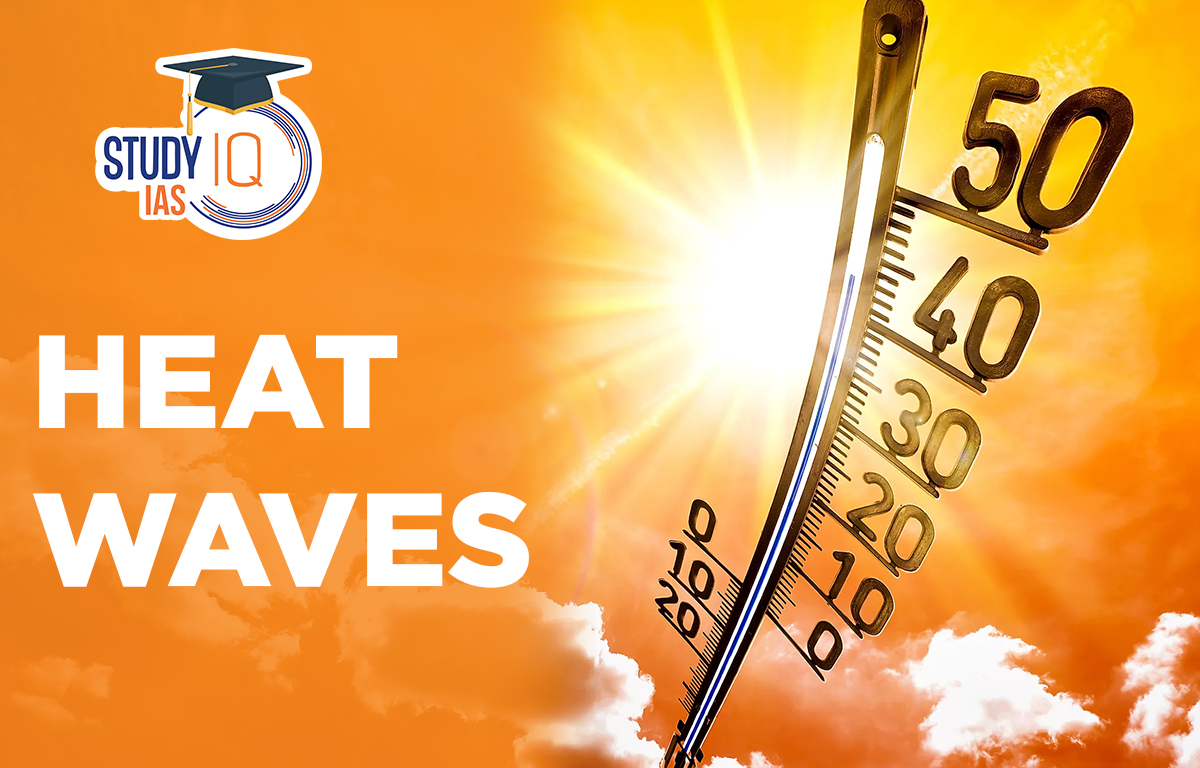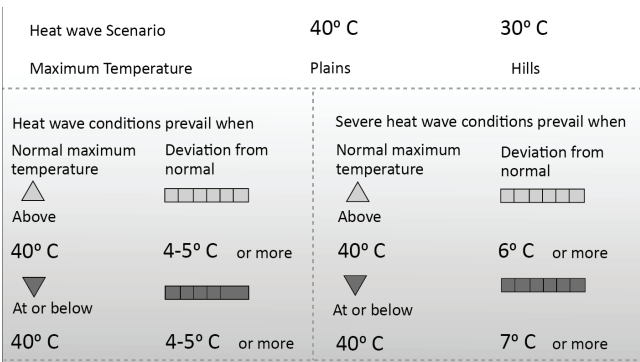Table of Contents
Context: A new study has found that most Indian cities’ Heat Action Plans (HAPs) lack long-term strategies to tackle extreme heat, and even when strategies exist, they are not effectively implemented.
About Heat Waves
Heat Waves is a period when the maximum temperature in a particular area reaches or exceeds 40 degrees Celsius for the Plains region, and at least 30 degrees Celsius for Hilly regions.
- The criteria for declaring heat waves vary based on the temperature climatology (historical temperatures) of different regions.
- The impact of heat waves is intensified by factors such as high humidity, high wind speed, and the duration of the heat wave events.
- Impact on Life: Heatwaves increase risks such as wildfires, crop damage, and health problems.
IMD definition of Heat Wave
- Plains: Maximum temperature ≥ 40°C, exceeding normal by 4.5-6.4°C.
- Hilly regions: Maximum temperature ≥ 30°C, exceeding normal by 4.5-6.4°C.
- Additionally, a heatwave can be declared if:
- Maximum temperature ≥ 45°C
- Maximum temperature ≥ 47°C (severe heatwave)
- Qualitatively: When air temperature becomes hazardous to human health.
What is a Heat Action Plan (HAP)?
- A Heat Action Plan is an early warning system and preparedness plan for extreme heat events. HAPs include:
- Immediate as well as long-term actions to increase preparedness.
- Information-sharing and response coordination.
- Reducing health impacts of extreme heat, especially on vulnerable populations.
- Ahmedabad is the first city in the country to have its own heat action plan. It implemented a comprehensive HAP in 2013.
| Fact |
|
Findings of Recent Study
- Research Approach: Classified heat waves based on temperature, area (over a million square kilometres), and duration (more than three days).
- Tracked the movement and speed of heat waves.
- Heatwave Dynamics:
- Heatwaves slowed down by nearly 8 km/day each decade.
- Lasted longer by about four days.
- Frequency increased from about 75 events (1979-1983) to approximately 98 events (2016-2020).
- Effects more pronounced in North America and Eurasia.
- Jet Stream Analysis:
- The jet stream has weakened over the years, affecting the movement of heat waves.
- Jet streams guide atmospheric waves that influence surface temperatures.
- Weaker jet streams lead to more persistent and slow-moving weather events.
- Human Activity: Simulations with and without greenhouse gas emissions indicated human activity has significantly contributed to slower and longer-lasting heat waves.
Future Research and Adaptation
- Next Steps:
- Further analysis of atmospheric air circulation patterns.
- Exploration of country-specific changes in heatwaves.
- Development of climate adaptation strategies.
- Mitigation Strategies:
- Urban areas: Planting more trees and increasing green infrastructure.
- Education: Teaching climate adaptation strategies, involving community projects.
Criteria for Declaring a Heatwave
| Criteria | Details |
| Criteria for Declaring a Heat Wave |
|
| Based on Departure from Normal |
|
| Based on Actual Maximum Temperature |
|
| Declaration Criteria |
|
Heat Waves Causes
- When there is high atmospheric pressure, hot air is forced downward and trapped close to the ground, resulting in heat waves. The hot air is kept from rising thanks to this high-pressure system, which functions like a lock. As a result, rain cannot form, and the air temperature rises.
- Ambient temperatures may feel 3 to 4 degrees warmer than they actually are due to urban heat island effects.
- As global temperatures have increased by an average of 0.8 degrees over the previous century, more heat waves were anticipated. Temperatures at night are increasing as well.
- Globally, heat waves that last longer and are more powerful are becoming more often as a result of climate change.
- High UV radiation intensity in areas of moderate to high heat. India is susceptible to heat waves due to a combination of extreme heat stress and a largely rural population.
Causes of Increased Heat Wave Days
- Climate change: A study in PLOS Climate (April 2023) shows heatwaves are becoming more frequent, intense, and lethal globally.
- Over 90% of India could be impacted by abnormal temperatures due to climate change.
- Increased heat waves have severe consequences:
- Livelihoods
- Food production
- Disease spread
- Human health (heat stress, death) according to WHO
- El Niño contributes to higher temperatures and increased heat wave occurrence.
Heat Waves Impact
1. Economic Effects
The frequent occurrence of heat waves hurts numerous economic sectors. For instance, the reduction in working days hurts the livelihood of poor and marginal farmers. The productivity of daily wage workers is negatively impacted by heat waves, which affects the economy.
Crop yields are impacted negatively when temperatures are higher than they should be in the agriculture sector. Wheat crop losses during the previous rabi season have been reported by farmers in Haryana, Punjab, and Uttar Pradesh. Due to heat waves, wheat production could be down 6-7% throughout India.
2. Impact on Humans
Rising temperatures, a lack of public awareness campaigns, and insufficient long-term mitigation measures all contribute to heat-related mortality. A 2019 analysis from the Tata Centre for Development and the University of Chicago predicts that by 2100, more than 1.5 million people per year may pass away from heat-related deaths brought on by climate change.
As the temperature rises, more people will contract illnesses like diabetes, cardiovascular and respiratory problems, and mental health issues. As the temperature rises, more people will contract illnesses like diabetes, cardiovascular and respiratory problems, and mental health issues.
3. Impact on Livestock
According to Cornell University researchers, increased heat stress could cause milk outputs in India’s arid and semi-arid dairy farming to decline by 25% by 2100 (compared to 2005 levels).
Heatwaves unavoidably increase the electricity demand. The average daily peak demand in North India was 13% greater in April than it was in 2021, and it was 30% higher in May.
4. Impact on Food Security
Tree mortality and agricultural production losses are being brought on by the simultaneous occurrence of heat and drought disasters. The rapid decreases in food production caused by heat-related labour productivity losses will increase the dangers to human health and food production.
In particular, in tropical areas, these interrelated effects will raise food costs, lower household incomes, and cause hunger and climate-related fatalities.
5. Impact on Workers
Given that a big portion of India’s population depends on industries like agriculture and construction for a living, these workers will be badly impacted in 2030. Weaker Sections to Be Affected in Particular: Unless greenhouse gas and aerosol emissions are drastically reduced globally, the climate science community has documented overwhelming evidence that severe events like heatwaves are projected to grow more intense, more frequent, and of longer length in the future.
It is crucial to keep in mind that heatwaves in India, like the one that is currently occurring, have the potential to affect thousands of weak and underprivileged individuals who made minimal contributions to the global warming catastrophe.
Measures to Manage Heat Wave Impact
- The Election Commission (EC) issued an advisory for upcoming elections (April 19 – June 1) coinciding with summer and potential heatwaves:
- Carrying water bottles
- Protecting oneself from sunlight
- Wet bulb temperature: Crucial indicator for heat stress and potential health risks.
- Deadly conditions can occur even outside a heatwave if the wet bulb temperature exceeds 30-35°C.
Heat Waves Mitigation
1. Heat Waves Action Plan
- A Heat Waves Action Plan is necessary for heatwave zones to decrease the impact of heatwaves due to the negative effects of heat waves and the need for effective disaster adaption techniques and more robust disaster management regulations.
- The government must prioritise creating a long-term action plan to protect people, animals, and wildlife because heat-related deaths can be avoided.
- The Sendai Framework for Disaster Risk Reduction 2015–30 needs to be implemented effectively, with the State taking the lead and other stakeholders sharing responsibility.
2. Implementing Climate Action Plans
- To promote equitable growth and ecological sustainability, the National Action Plan for Climate Change (NAPCC) should be implemented in its true spirit.
- Not only should nature-based solutions be considered to combat climate change, but also to do it in a way that is moral and supports intergenerational fairness.
3. Early Warning Systems and Public Awareness
- To reduce the number of fatalities caused by heat waves, it is important to raise public awareness through print, electronic, and social media, provide heat-proof shelters in summer in areas that are prone to them, make public drinking water easier to access, and implement afforestation programmes in both urban and rural areas.
- By putting in place effective early warning systems that communicate heatwave hazards, suggest various preventative measures and limit disaster repercussions, heat wave fatalities can be avoided.
4. Recognition of Heat Waves as a Natural Disaster
- Recognizing heat waves as a form of natural disaster It is past time to acknowledge heat waves as a serious catastrophe. India still has a ways to go in raising general understanding, especially about how people and small communities may look after themselves.
- The state and district governments could create a regional heatwave action plan with the aid of a declaration of heat waves as a natural disaster. Clear rules must also be established governing when to close schools and how long people must spend outside if it cannot be helped.
5. Sustainable Cooling
- For both residential and commercial buildings, passive cooling technology, a popular technique for designing naturally ventilated structures, can be a critical alternative to combat the urban heat island.
- In the third section of its AR6 report, the Intergovernmental Panel on Climate Change (IPCC) suggested that in the context of global warming, ancient Indian architectural designs that have utilised this technique can be applied to modern structures.
6. Change of Dark Roofs
- Cities have darker roadways, parking lots, and roofs than rural regions, which absorb and hold heat. This is a major factor in cities being hotter than rural places. Replace the dark surfaces with lighter, more reflecting materials as one of the long-term remedies; this will produce a noticeably cooler environment.
7. Climate-Resilient Crops
- To determine if the crops we have relied on in the past will continue to supply food and nutrition security in the future, it is necessary to have a dynamic understanding of hazards. It will be necessary to make arrangements for crop loss insurance, and diversified cropping should be encouraged.



 Places in News for UPSC 2026 for Prelims...
Places in News for UPSC 2026 for Prelims...
 Lake Natron: Location, Features, Wildlif...
Lake Natron: Location, Features, Wildlif...
 Erra Matti Dibbalu Added to UNESCO Tenta...
Erra Matti Dibbalu Added to UNESCO Tenta...

























